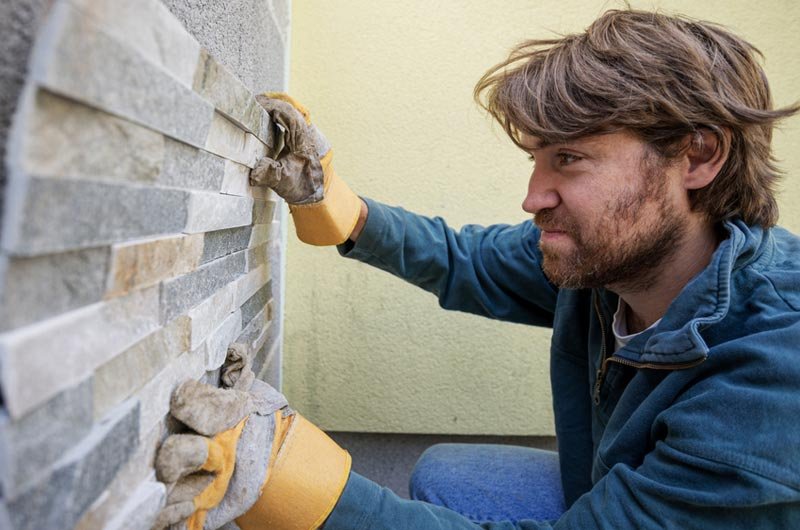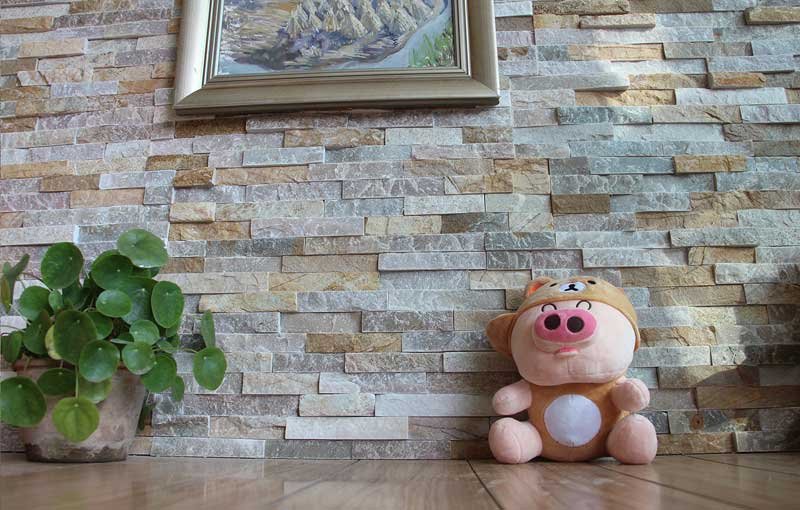屋外の積み重ねられた石は、あらゆる風景機能や家の外観に否定できない優雅さと価値を追加します。ただし、天候にさらされると、ひび割れ、染色、水による損傷などの問題が発生する可能性があり、無視された場合、美しい投資を費用のかかる修理の仕事に変える可能性があります。
これらの設置の永続的な美しさと構造的完全性を確保することは、適切なケアにかかっています。専門のメーカーとしての私たちの経験を利用しています 高品質の天然石製品、一貫したメンテナンスが重要であることを理解しています。このガイドは、住宅所有者が屋外を保護するのを助けるために、クリーニングとシーリングから検査ルーチンまでの実用的なヒントを提供します 積み上げられた石 and keep it looking pristine for years to come.
5 Essential Tips for Outdoor Stacked Stone Installation and Issue Prevention
Building an attractive exterior feature with outdoor stacked stone adds significant curb appeal and value to your home. However, the beauty and longevity of these structures depend heavily on correct installation and understanding potential problems. Getting the foundation right from the start saves time, money, and headaches down the road. This guide explores why proper techniques matter and how to spot common issues.
Proper installation of stacked stones is the key factor in ensuring the structure remains beautiful and sound for years, preventing costly repairs later.
The Importance of Correct Installation: Preventing Future Headaches
Think of proper installation as the bedrock of your stacked stone project. Skipping steps or using incorrect methods during the installation of stacked stones can lead to serious problems. These include structural instability, water damage, and unattractive cracking. It’s crucial to prepare the surface correctly, use the right type of mortar or adhesive, and ensure adequate support for the stone’s weight.
Following guidelines on how to build outdoor stacked stone wall features, like those provided by experienced suppliers, makes a huge difference. A well-installed wall resists the elements and stands strong for decades. Investing in professional installation or carefully following expert advice ensures your project’s success and minimizes the need for future interventions. Attention to detail during this phase is paramount.
Common Culprits: Understanding Cracking in Stacked Stone Walls
Cracks are one of the most concerning issues for homeowners with stacked stone walls. Often, water intrusion is the primary cause. When water seeps behind the stones and freezes, it expands, putting pressure on the stone and mortar. This freeze-thaw cycle can cause significant cracking over time, compromising both the look and stability of the wall.
Improper base preparation or settling of the ground beneath the wall can also lead to stress fractures. Using low-quality materials that aren’t suited for outdoor conditions contributes to weakness. Understanding these causes helps in preventing cracks in stacked stone structures through better planning and material selection, ensuring long-term durability.
Identifying Water Damage: Efflorescence and Moisture Penetration Signs
Water damage often shows up subtly at first. One common sign is efflorescence – a white, powdery residue left on the stone surface as water evaporates. While sometimes just cosmetic, it indicates moisture is moving through the wall, potentially leading to bigger problems. Dark spots or damp patches that persist after rain are clearer signs of moisture penetration.
Look closely at mortar joints; crumbling or missing mortar allows water easier access behind the stones. Mold or mildew growth is another red flag indicating excessive moisture. Early identification and addressing the source of water intrusion, like improving drainage or sealing the stone, can prevent more severe structural damage to exterior stone wall designs。
Staining and Discoloration: Environmental Factors and Material Choices
Stacked stone walls can become stained or discolored over time due to various factors. Environmental elements like rain carrying minerals, nearby soil splashing up, or even air pollution can leave marks. Rust stains might appear if metal elements are nearby or if the stone itself contains iron deposits that react with moisture.
The type of stone chosen also plays a role. Porous stones are more susceptible to absorbing liquids and staining compared to denser options. Choosing materials known for their resistance to staining and sealing the stone appropriately can help maintain the original appearance. Regular, gentle cleaning helps manage surface dirt before it becomes a permanent stain.
Choosing the Right Stone: Durability and Weather Resistance for Longevity
Selecting the right material is perhaps the most critical decision for ensuring the longevity of your outdoor stacked stone feature. Not all stones are created equal when it comes to handling harsh weather. Look for dense, low-absorption stones like certain quartzites, slates, or granites, which perform well in varied climates, especially those with freeze-thaw cycles.
Consider the specific environmental challenges of your location. Is it very wet? Subject to freezing temperatures? High UV exposure? Reputable suppliers, such as Top Source Slate, emphasize quality control and offer materials specifically tested for durability and weather resistance. Choosing a high-quality, appropriate stone type is like picking a “ライドオアディー” partner for your home’s exterior – reliable and long-lasting. This upfront investment pays off by minimizing maintenance and ensuring the structural integrity of your stacked stone walls for years to come.
Comparing Common Outdoor Stacked Stone Materials
| 石の種類 | Durability Rating (1-5, 5=Highest) | Water Absorption Rate | Freeze-Thaw Resistance (Cycles Tested) | Typical Cost Range ($/sq ft) | Notes & Best Use Cases |
|---|---|---|---|---|---|
| スレート | 4 | Low (<0.4%) | High (Often 100+ cycles) | $8 – 20ドル | Good weather resistance, natural cleft texture. Ensure sourcing from reputable suppliers for consistent quality like Top Source Slate offers. |
| 珪岩 | 5 | Very Low (<0.2%) | Very High (Often 150+ cycles) | $12 – 30ドル | Extremely durable, resists weathering and staining. Ideal for harsh climates. |
| トラバーチン | 3 | Moderate (1-3%) | Moderate (Depends on density/fill) | $10 – 25ドル | Porous, better suited for mild climates or requires sealing. Less ideal where freeze-thaw is common. |
| 石灰岩 | 2-3 | Moderate to High (2-7%) | 低から中程度 | $9 – $22 | Softer stone, prone to weathering and acid rain damage. Best in dry, mild climates; requires sealing. |
| 砂岩 | 3 | Moderate to High (1-8%) | Variable (Depends on binder) | $7 – $18 | Absorption varies greatly. Choose denser varieties for outdoors. Sealing recommended, especially in wet areas. |
Keep Your Stone Looking Great: Essential Maintenance Routines for Lasting Beauty
Your outdoor 積み上げられた石 features add incredible style and value to your property. But like any exterior element, they need some care to stay looking their best and structurally sound. Regular maintenance is key to preserving their beauty and preventing small issues from becoming big problems. Think of it as protecting your investment for the long haul.
Consistent maintenance routines are the most effective way to ensure your outdoor stacked stone retains its aesthetic appeal and structural integrity over many years.
Routine Cleaning Schedule: Keeping Dirt, Algae, and Stains at Bay
Regular cleaning prevents the buildup of everyday grime, pollen, algae, and moss, especially in damp or shaded areas. Aim for a light cleaning once or twice a year, typically in the spring and fall. This involves gently removing loose debris and surface dirt. For areas prone to algae or mildew, more frequent spot cleaning might be needed.
Consistent 天然石の壁 maintenance helps avoid stubborn stains that can penetrate the stone’s surface. Addressing spills or potential staining agents like fallen leaves or berries promptly is much easier than tackling set-in discoloration later. A simple rinse with water after gardening nearby can also prevent soil stains on the lower portions of the wall.
Safe Cleaning Techniques: Using Soft Brushes and Mild Detergents
When cleaning your stone, gentleness is key. Start with a soft-bristled brush or a cloth and plain water to remove loose dirt. If water alone isn’t enough, use a pH-neutral cleaner specifically designed for natural stone or a very mild detergent mixed with water. Always test the cleaner on an inconspicuous spot first to ensure it doesn’t discolor or damage the stone.
Avoid using harsh chemicals like bleach, acid-based cleaners (like vinegar), or abrasive scrubbing tools. These can etch, stain, or permanently damage the stone surface and potentially weaken the mortar joints. Pressure washers should also be used with extreme caution, on a low setting, and held at a distance to avoid dislodging stones or forcing water into joints. When in doubt, stick to simpler methods.
Annual Inspection Checklist: Identifying Cracks, Loose Stones, and Water Damage Early
Performing a thorough visual inspection at least once a year is crucial. Look closely for any hairline cracks in the stones or mortar. Check if any stones feel loose or unstable when gently pushed. Examine joints for crumbling or missing mortar, which can allow water entry.
Also, scan for signs of water damage like persistent damp spots, efflorescence (white powdery deposits), or mold/mildew growth. Pay special attention to the base of the wall and areas near downspouts or irrigation. Catching these issues early makes repairs simpler and less costly, preserving the integrity of your ストーンベニア outdoors.
The Importance of Drainage: Clearing Debris from the Wall Base
Proper drainage around the base of your stacked stone wall is critical. Leaves, soil, mulch, and other debris can accumulate against the wall, trapping moisture. This constant dampness can lead to staining, promote biological growth like moss and algae, and contribute to water seeping behind the stones, especially during freeze-thaw cycles.
Make it a regular task, especially during fall and spring, to clear away any buildup from the base of the wall. Ensure the ground slopes away from the structure so water naturally flows away. Maintaining clear drainage pathways is one of the simplest yet most effective best practices for maintaining stone walls and preventing moisture-related damage.
Seasonal Check-ups: Preparing Your Stone for Changing Weather
Adjust your maintenance based on the season. Before winter, ensure drainage is clear to prevent ice buildup near the base. Inspect for any cracks or loose mortar where water could enter, freeze, and expand, causing damage. A quick check can save you a “boatload” of trouble when temperatures drop.
In the spring, clean off any accumulated winter grime or de-icing salt residue (if applicable). Check again for any damage that might have occurred during freezing weather. Proactive seasonal care helps your outdoor stacked stone withstand weather changes year after year. For homeowners seeking convenience, exploring maintenance packages from specialists can ensure consistent, professional care, protecting the property’s value.
Stacked Stone Cleaning Agent Comparison
| Cleaning Agent | Effectiveness (Scale 1-5) | Suitable Stone Types | Safety/Environmental Notes | Application Method | Cost Estimate (per Gallon/Concentrate) |
|---|---|---|---|---|---|
| Plain Water | 2 | 全て | Safest, most environmentally friendly. | Hose rinse, soft brush. | Minimal (Water Bill) |
| pH-Neutral Stone Cleaner | 4 | Most 天然石 (Slate, Quartzite, Granite, Travertine) | Generally safe for stone and environment when used as directed. Biodegradable options available. | Dilute as instructed, apply with brush/sprayer, rinse thoroughly. | 20ドル – 40ドル |
| Mild Detergent (e.g., Dish Soap) | 3 | Most non-sensitive stones (Test first) | Use sparingly, rinse completely to avoid residue. Choose biodegradable options. | Highly diluted, soft brush, thorough rinse. | $5 – $15 |
| Oxygen Bleach Based Cleaner | 4 (for organic stains) | Many durable stones (Test first, avoid acid-sensitive ones like Limestone) | Less harsh than chlorine bleach, breaks down into water/oxygen. Can lighten stone slightly. | Follow product instructions, apply, light scrub, rinse well. | 25ドル – 50ドル |
| Specialized Poultice (for specific stains) | 5 (for target stain) | Varies by stain & stone type | Specific formulations for oil, rust, etc. Follow safety data sheets (SDS). | Applied as paste, covered, left to dwell, removed carefully. | 30ドル – $100+ (depending on type/size) |
Protect and Repair: Advanced Care for Your Outdoor Stacked Stone
Beyond routine cleaning, taking proactive steps like sealing and promptly addressing repairs is essential for the long-term health and appearance of your outdoor 積み上げられた石. These advanced measures safeguard against weather damage and prevent minor issues from escalating into costly structural problems. Understanding how to protect and repair your investment ensures it remains a beautiful feature for years.
Applying the right sealant and making timely repairs can significantly extend the life and beauty of stacked stone walls, preventing major restoration costs later.
To Seal or Not to Seal? Protecting Your Outdoor Stacked Stone from Moisture
The decision to seal outdoor stacked stone depends on the stone type and local climate. Sealing provides a protective barrier against moisture absorption, which is crucial for preventing water damage, efflorescence, staining, and freeze-thaw cycle issues. For porous stones like sandstone or limestone, sealing is highly recommended, especially in wet or freezing climates.
However, dense stones such as high-quality quartzite or slate, like those rigorously tested by Top Source Slate, may not always require sealing due to their naturally low absorption rates. Over-sealing or using the wrong type can sometimes trap moisture. Consider your specific stone and environment when deciding; proper sealing is a key component of weatherproofing stone walls effectively.
Choosing the Right Sealant: Penetrating vs. Topical Sealers for Weatherproofing Stone Walls
Two main types of sealants exist: penetrating and topical. Penetrating sealers soak into the stone, creating an invisible barrier below the surface without significantly changing the stone’s appearance. They are breathable, allowing trapped moisture vapor to escape, which is vital for preventing damage in fluctuating temperatures.
Topical sealers form a film on the stone’s surface, often enhancing color and providing a gloss or semi-gloss finish. While they offer good stain protection, they can trap moisture, may become slippery when wet, and often require more frequent reapplication as the surface layer wears off. For most outdoor applications, especially stacked stone walls, breathable penetrating sealers are generally preferred for durability and performance.
Proper Sealant Application Techniques for Maximum Protection
Applying sealant correctly ensures it performs as intended. First, the stone surface must be completely clean and dry; applying sealant over dirt or moisture traps it underneath. Always follow the manufacturer’s specific instructions, as application methods vary. Typically, sealants are applied using a low-pressure garden sprayer, roller, or brush.
Apply evenly, avoiding pooling or drips. Penetrating sealers often require wiping off excess product after a short dwell time. Two thin coats may be more effective than one thick coat. Proper application temperature, usually moderate and dry conditions, is also important for curing. Choosing a quality sealant, recommended by experts familiar with natural stone like Top Source Slate, is worth its weight in gold.
Addressing Minor Cracks: Patching Compounds and Techniques
Small cracks in mortar joints or even hairline fractures in stones should be addressed promptly to prevent water infiltration. For mortar cracks, specialized masonry crack fillers or matching mortar repair compounds can be used. Clean the crack thoroughly, removing any loose debris before application. Follow product instructions for mixing and applying the filler, ensuring it bonds well.
Hairline cracks in the stone itself might be stabilized with clear epoxy designed for stone, though this can sometimes alter appearance slightly. Addressing these minor issues early is a core part of preventing cracks in stacked stone from worsening and maintaining the wall’s structural integrity. This is one of the best practices for maintaining stone walls effectively.
When to Call a Professional: Dealing with Major Structural Issues or Stone Replacement
While minor repairs are often DIY-friendly, certain situations warrant professional help. Significant structural cracks, leaning or bulging walls, widespread crumbling mortar, or multiple loose or fallen stones indicate potentially serious underlying issues. These problems might stem from foundation settlement, improper installation, or severe water damage.
Attempting major repairs without expertise can worsen the problem or lead to unsafe conditions. A qualified mason or stone restoration specialist can assess the cause, recommend the correct solution, and perform repairs safely, ensuring the long-term stability of your stacked stone walls. Don’t hesitate to call for help when the issue seems complex or structural.
Long-Term Savings: How Consistent Maintenance Protects Your Investment
Consistent maintenance, including cleaning, sealing, and timely repairs, might seem like effort, but it translates directly into long-term savings. Proactive care prevents minor issues like small cracks or localized staining from escalating into major, expensive restoration projects involving structural rebuilding or extensive stone replacement. It preserves the aesthetic value and curb appeal of your property.
Investing in quality materials from the start, like those ensured by Top Source Slate’s rigorous quality control, combined with diligent maintenance, protects your investment. Proper care ensures your outdoor stacked stone feature remains sound, beautiful, and valuable for decades, ultimately costing less than dealing with neglect down the line. It aligns with achieving longevity and weather resistance for your home.
Comparison of Outdoor Stone Sealant Types
| Sealant Type | Base Chemistry | Appearance Effect | Breathability (Vapor Permeability) | Expected Longevity (Years) | Typical Cost ($/sq ft applied) | Primary Benefit |
|---|---|---|---|---|---|---|
| Silane/Siloxane Penetrating Sealer | Solvent or Water-Based | Natural/Invisible | 高い | 5-10+ | $0.75 – $1.50 | Deep penetration, durable water repellency, breathable. Excellent for freeze-thaw. |
| Fluoropolymer Penetrating Sealer | Solvent or Water-Based | Natural/Invisible | 高い | 3-7 | $1.00 – $2.00 | Excellent oil and water repellency, good stain resistance, breathable. |
| Silicone Penetrating Sealer | Water-Based | Natural/Invisible | 中程度から高 | 2-5 | $0.50 – $1.00 | Cost-effective water repellency for less demanding applications. |
| Acrylic Topical Sealer | Water or Solvent-Based | Slight Sheen to Glossy, Enhancing | 低い | 1-3 | $0.40 – $0.90 | Enhances color, provides surface stain protection. Requires frequent reapplication. Can trap moisture. |
| Polyurethane Topical Sealer | Water or Solvent-Based | Satin to Glossy, Enhancing | Very Low | 3-5 | $1.25 – $2.50 | Durable surface film, high abrasion resistance. Primarily for horizontal surfaces, can trap moisture significantly. |
結論
After spending over 15 years in the natural stone industry, I’ve seen time and again that maintaining your outdoor 積み上げられた石 isn’t just about aesthetics—it’s crucial for protecting its integrity against the elements. Consistent care really does make all the difference in keeping those features looking great year after year.
From routine cleaning and inspections to thoughtful sealing and prompt repairs, these practices safeguard your investment. Choosing quality, weather-appropriate stone from the start certainly helps, but even the best materials benefit from proactive maintenance to prevent small issues turning into big, expensive problems.
Ultimately, putting in a little effort regularly ensures your beautiful stone walls stay structurally sound and visually appealing for the long haul. Compared to tackling major repairs later, keeping up with maintenance is a “簡単です”。


